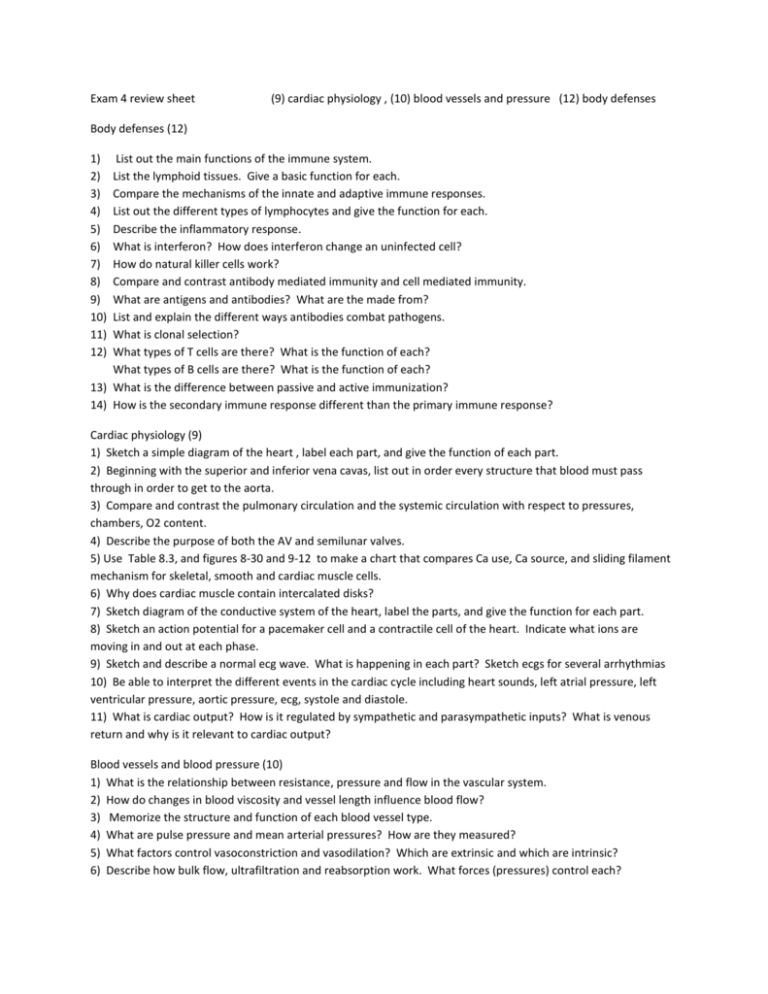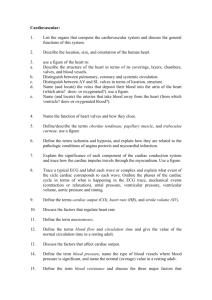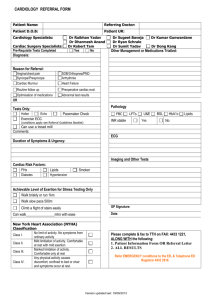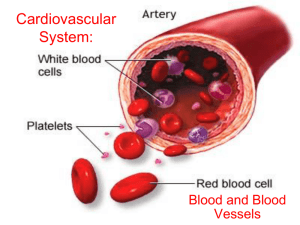Review sheet exam 4
advertisement

Exam 4 review sheet (9) cardiac physiology , (10) blood vessels and pressure (12) body defenses Body defenses (12) 1) 2) 3) 4) 5) 6) 7) 8) 9) 10) 11) 12) List out the main functions of the immune system. List the lymphoid tissues. Give a basic function for each. Compare the mechanisms of the innate and adaptive immune responses. List out the different types of lymphocytes and give the function for each. Describe the inflammatory response. What is interferon? How does interferon change an uninfected cell? How do natural killer cells work? Compare and contrast antibody mediated immunity and cell mediated immunity. What are antigens and antibodies? What are the made from? List and explain the different ways antibodies combat pathogens. What is clonal selection? What types of T cells are there? What is the function of each? What types of B cells are there? What is the function of each? 13) What is the difference between passive and active immunization? 14) How is the secondary immune response different than the primary immune response? Cardiac physiology (9) 1) Sketch a simple diagram of the heart , label each part, and give the function of each part. 2) Beginning with the superior and inferior vena cavas, list out in order every structure that blood must pass through in order to get to the aorta. 3) Compare and contrast the pulmonary circulation and the systemic circulation with respect to pressures, chambers, O2 content. 4) Describe the purpose of both the AV and semilunar valves. 5) Use Table 8.3, and figures 8-30 and 9-12 to make a chart that compares Ca use, Ca source, and sliding filament mechanism for skeletal, smooth and cardiac muscle cells. 6) Why does cardiac muscle contain intercalated disks? 7) Sketch diagram of the conductive system of the heart, label the parts, and give the function for each part. 8) Sketch an action potential for a pacemaker cell and a contractile cell of the heart. Indicate what ions are moving in and out at each phase. 9) Sketch and describe a normal ecg wave. What is happening in each part? Sketch ecgs for several arrhythmias 10) Be able to interpret the different events in the cardiac cycle including heart sounds, left atrial pressure, left ventricular pressure, aortic pressure, ecg, systole and diastole. 11) What is cardiac output? How is it regulated by sympathetic and parasympathetic inputs? What is venous return and why is it relevant to cardiac output? Blood vessels and blood pressure (10) 1) What is the relationship between resistance, pressure and flow in the vascular system. 2) How do changes in blood viscosity and vessel length influence blood flow? 3) Memorize the structure and function of each blood vessel type. 4) What are pulse pressure and mean arterial pressures? How are they measured? 5) What factors control vasoconstriction and vasodilation? Which are extrinsic and which are intrinsic? 6) Describe how bulk flow, ultrafiltration and reabsorption work. What forces (pressures) control each?









